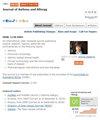计算机断层扫描对评估日本重症哮喘患者支气管热成形术效果的实用性
IF 3.7
3区 医学
Q2 ALLERGY
引用次数: 0
摘要
背景:支气管热成形术(BT)可改善重症哮喘患者的临床疗效和生活质量,并且在之前的 CT 研究中显示气道狭窄和空气潴留持续减少。然而,目前还缺乏对日本重症哮喘患者接受 BT 术后临床疗效的全面分析,包括 CT 评估。本研究旨在评估 BT 对日本哮喘患者的影响,重点采用 CT 指标 "Pi10 时的 WA "来评估气道疾病:对 12 名接受 BT 的重度持续性哮喘患者进行了评估,评估方法包括 ACQ6、AQLQ、肺功能测试、FeNO 测量、血液采样以及 BT 前和第三次上叶手术后一年的胸部 CT:患者的中位年龄为 62.0 岁,7/12(58.3%)为男性,4/12(33.3%)使用常规口服皮质类固醇,8/12(66.7%)接受生物制剂治疗。FEV1% 中位数为 73.6%,外周嗜酸性粒细胞计数中位数为 163.8/μL。BT 一年后,ACQ6 分数从 2.4 分提高到 0.8 分(p = 0.007),AQLQ 分数从 4.3 分提高到 5.8 分(p < 0.001)。在 Pi10 时,哮喘加重、因加重而计划外就诊、FeNO 和 √WA 也有显著改善(p < 0.05)。CT 结果中的基线粘液评分与 FEV1(r = - 0.688,p = 0.013)和最大中呼气流速(r = - 0.631,p = 0.028)呈负相关,与外周血嗜酸性粒细胞计数(r = - 0.719,p = 0.008)呈正相关。一年后,Pi10 √WA 的变化与粘液评分的变化呈正相关(r = 0.742,p = 0.007):本研究存在局限性,包括单臂观察设计和样本量较小。然而,BT 可改善重症哮喘患者的症状。CT 上经过验证的 "Pi10 处√WA "指标能有效评估日本哮喘患者在 BT 治疗后的治疗反应。本文章由计算机程序翻译,如有差异,请以英文原文为准。
Usefulness of Computed Tomography for Evaluating the Effects of Bronchial Thermoplasty in Japanese Patients with Severe Asthma
Background: Bronchial thermoplasty (BT) improves clinical outcomes and quality of life for patients with severe asthma and has shown sustained reductions in airway narrowing and air trapping in previous CT studies. However, there is a lack of a comprehensive analysis, including CT evaluation, of clinical outcomes in Japanese patients who have undergone BT for severe asthma. This study aimed to evaluate the impact of BT in Japanese asthma patients, with a focus on the CT metric “WA at Pi10” to assess airway disease.
Methods: Twelve patients with severe persistent asthma who underwent BT were assessed using ACQ6, AQLQ, pulmonary function tests, FeNO measurement, blood sampling, and chest CT before BT and one year after the third procedure for the upper lobes.
Results: The median age of the patient was 62.0 years, 7/12 (58.3%) were male, 4/12 (33.3%) used regular oral corticosteroids, and 8/12 (66.7%) received biologics. Median FEV1% was 73.6%, and median peripheral eosinophil count was 163.8/μL. After one year of BT, ACQ6 scores improved from 2.4 to 0.8 points (p = 0.007), and AQLQ scores improved from 4.3 to 5.8 points (p < 0.001). Significant improvements were also observed in asthma exacerbations, unscheduled visits due to exacerbations, FeNO, and √WA at Pi10 (p < 0.05). The baseline mucus score on the CT findings was negatively correlated with FEV1 (r = − 0.688, p = 0.013) and with the maximum mid-expiratory flow rate (r = − 0.631, p = 0.028), and positively correlated with the peripheral blood eosinophil count (r = − 0.719, p = 0.008). Changes in √WA at Pi10 after one year were positively correlated with changes in the mucus score (r = 0.742, p = 0.007).
Conclusion: This study has limitations, including its single-arm observational design and the small sample size. However, BT led to a symptomatic improvement in patients with severe asthma. The validated “√WA at Pi10” metric on CT effectively evaluated the therapeutic response in Japanese asthma patients after BT.
Methods: Twelve patients with severe persistent asthma who underwent BT were assessed using ACQ6, AQLQ, pulmonary function tests, FeNO measurement, blood sampling, and chest CT before BT and one year after the third procedure for the upper lobes.
Results: The median age of the patient was 62.0 years, 7/12 (58.3%) were male, 4/12 (33.3%) used regular oral corticosteroids, and 8/12 (66.7%) received biologics. Median FEV1% was 73.6%, and median peripheral eosinophil count was 163.8/μL. After one year of BT, ACQ6 scores improved from 2.4 to 0.8 points (p = 0.007), and AQLQ scores improved from 4.3 to 5.8 points (p < 0.001). Significant improvements were also observed in asthma exacerbations, unscheduled visits due to exacerbations, FeNO, and √WA at Pi10 (p < 0.05). The baseline mucus score on the CT findings was negatively correlated with FEV1 (r = − 0.688, p = 0.013) and with the maximum mid-expiratory flow rate (r = − 0.631, p = 0.028), and positively correlated with the peripheral blood eosinophil count (r = − 0.719, p = 0.008). Changes in √WA at Pi10 after one year were positively correlated with changes in the mucus score (r = 0.742, p = 0.007).
Conclusion: This study has limitations, including its single-arm observational design and the small sample size. However, BT led to a symptomatic improvement in patients with severe asthma. The validated “√WA at Pi10” metric on CT effectively evaluated the therapeutic response in Japanese asthma patients after BT.
求助全文
通过发布文献求助,成功后即可免费获取论文全文。
去求助
来源期刊

Journal of Asthma and Allergy
Medicine-Immunology and Allergy
CiteScore
5.30
自引率
6.20%
发文量
185
审稿时长
16 weeks
期刊介绍:
An international, peer-reviewed journal publishing original research, reports, editorials and commentaries on the following topics: Asthma; Pulmonary physiology; Asthma related clinical health; Clinical immunology and the immunological basis of disease; Pharmacological interventions and new therapies.
Although the main focus of the journal will be to publish research and clinical results in humans, preclinical, animal and in vitro studies will be published where they shed light on disease processes and potential new therapies.
 求助内容:
求助内容: 应助结果提醒方式:
应助结果提醒方式:


